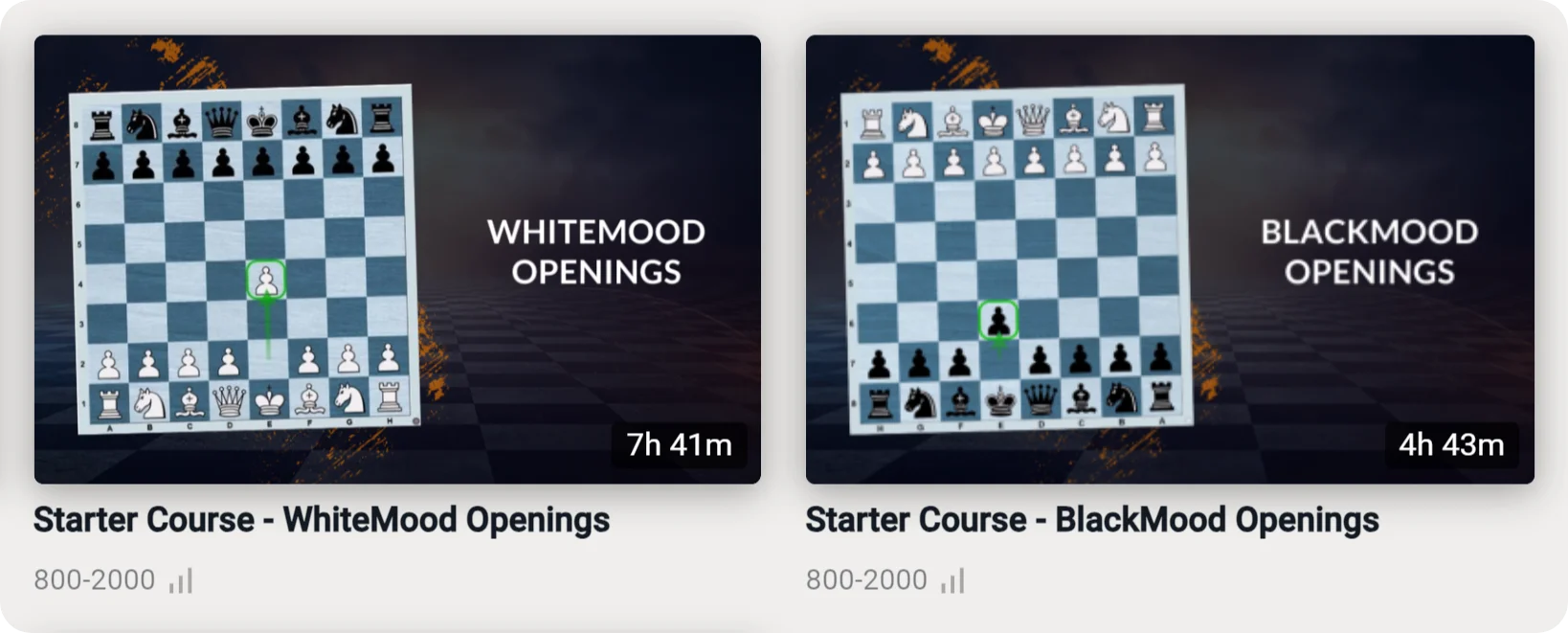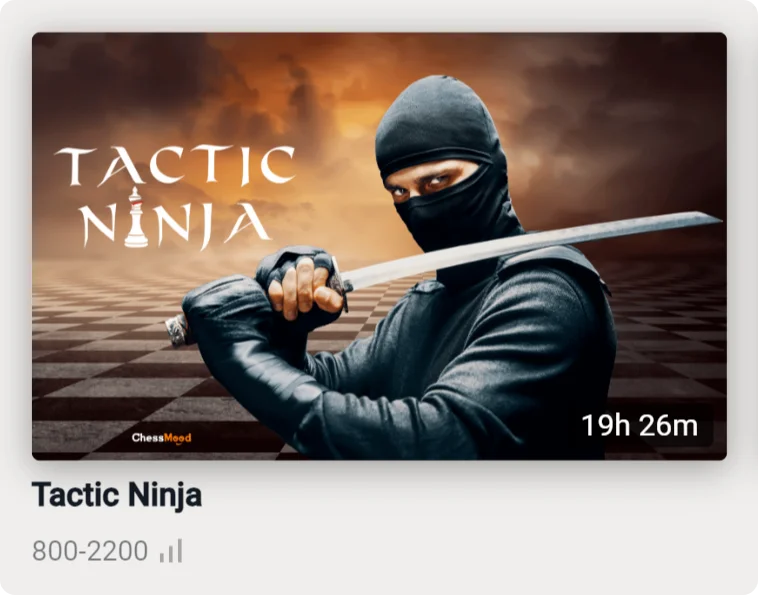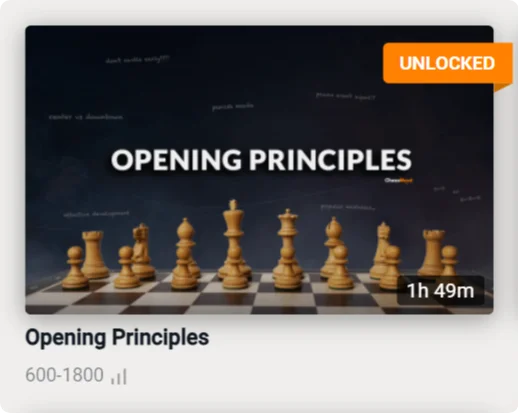The 2,000 rating is a milestone or a dream for most chess players.
Yet, not many achieve this.
Most people get stuck and confused between 1,500 to 2,000,
Theoretically, you can cross 1,500 just by playing, solving puzzles, and using your brilliant mind to figure out things.
But when you cross the 1,500 rating, the competition becomes tougher.
Most of your opponents know some openings, they have watched some YouTube videos, read articles or books, and watched some courses.
And if you’re like most chess players, you have also started looking into books, courses, and chess improvement tools around this level.
And then what happens?
You get confused in the chaos of information.
And if you have a budget, and a big desire to get to the 2,000 level, many companies will take advantage of this and sell you lots of stuff…
You buy lots of books and courses but you rarely finish them.
Does this relate to you?
If you said no, then great! You’re in a small minority.
Either way, I’ll give you an improvement plan that you can adapt specifically for your needs and start Rock’n’rolling!
When will you get a 2,000 rating?
This depends on how much time you can spend on chess and how accurately you’ll follow the improvement plan I’ll describe.
Unfortunately, you’ll not be the 1st one who achieved it by using this improvement plan, and you’ll not be the last.
But you’ll be in the 1% of the people who play chess and get there.
What if you never get there?
You can sue me 😁
Let’s go.
What do others do that is wrong?
The most common mistakes people make on this level are:
- Just playing and never studying
- Studying too much and not essential things. Playing too little, and never REALLY learning what they’ve studied.
- Not analyzing their games and not fixing their mistakes. And then they keep repeating the same errors over and over again.
- Jumping from one book to another. From one course or website to another and aimlessly wandering, trying to find that magic pill. While in reality, all that is required is to have the right sources, the right improvement plan, and the right discipline.
What will you do differently?
These 5 steps:
- Maintain the right balance between studying, practicing, and fixing
- Study precisely what you need
- Know how to practice effectively
- Correct your main mistakes
- Have the right mindset and keep the discipline
Step 1 - The Right Balance
Please read the following article and come back.
It’s essential.
https://chessmood.com/blog/how-to-get-better-at-chess
Thanks!
Now you know the key to chess growth for every level!
The question is, what’s the right balance for your level?
For getting to the 2,000 level, you should keep around this ratio:
Study - 45%
Practice - 45%
Fix - 10%
As you’ve learned in the above article, you’ll need to “eat” information by studying and then “digest” it by practicing.
Sometimes, you can dramatically change this ratio.
For example:
You can spend a week creating a new opening repertoire.
You almost don’t play. But the next week you start playing a lot and “digesting” the information.
So it might look like something like this:
Week 1:
Study - 100%
Practice - 0%
Fix - 0%
Week 2:
Study - 0%
Practice - 70%
Fix- 30%
(As you play a lot, and you learn lots of new things, you’ll make lots of mistakes. That’s why you spend more than the usual 10% of your time on fixing.)
But in the long term, the overall balance should be around the mentioned 45% study, 45% practice, and 10% fix.
Step 2 - Study
All you need for getting to the 2,000 level is to master these 4 essential areas:
- Tactics
- Opening
- Middlegame
- Endgame
First, I’ll explain to you how to work on each of these areas and then what balance I recommend maintaining.
1. Tactics
How should you sharpen your tactical skills?
Very easy.
You don’t need different books, software, and all kinds of different stuff.
We have your back covered.
You just go through these 3 courses:
Course 1 - Tactic Ninja
https://chessmood.com/course/tactic-ninja
It’s not just a course. It’s Tactics training!
It goes topic-by-topic and comes with 1,000 puzzles.
Follow the course instructions, and you’ll notice how your tactical skills improve daily.
Note: The first sections should be easy for you. But it’ll become more and more interesting and challenging after each section.
In case you need proof that you should watch the Tactic Ninja, try to solve this quiz with 777 puzzles from the course:
https://chessmood.com/quiz/the-tactic-ninja
Did you find it’s not easy? 😊
I told you!
Watch the course, amigo 😊
Especially sections 25-28 will be invaluable for you.
You’ll learn:
- How to notice tactics and hidden tactics
- The three key questions technique
And much more
Course 2 - Mating Matador
The next step to further improving your tactics is to learn Mating Patterns.
We have a detailed course with 37 Mating Patterns.
https://chessmood.com/course/mating-matador
If you follow the course instructions, the day you complete both courses, you’ll be amazed at how much you’ve sharpened your tactical skills and how frequently you’ve started to notice them during the games.
And after finishing, I recommend coming back to the courses from time to time and going through the quizzes.
As you’ll find in the instructions for the courses, you need to get to the point when you see the puzzle and solve it in less than 3 seconds.
P. S. Here is an additional article on how to improve chess tactics:
https://chessmood.com/blog/improve-chess-tactics
Course 3 - BlunderProof
https://chessmood.com/course/blunderproof
As you’ll see, there are lots of psychological factors which will affect your tactical vision.
Also, reducing your blunders and noticing your opponents' blunders will be critical for raising your rating.
You’ll learn all the causes of blunders and how to avoid them. How you can stay focused and notice hidden tactics, and much more…
2. Opening
The 3 main mistakes people make
Most players make 3 main mistakes at this stage:
- They study openings without a fundamental understanding of the opening principles and the philosophy of the opening fight. As a result, they blindly memorize variations without understanding the fundamentals of the opening dynamics.
- They study openings too deeply, trying to win the game from the opening or trying to know everything.
- They study lots of trappy openings and variations. Yeah, they might win some rating points in the short term, but they lay a very bad foundation for their future growth.
Here is what I recommend you do:
1. Develop a strong foundation
At this level, almost everyone thinks they know the opening principles.
- Develop the pieces
- Fight for the center
- Castle early
But…!
The 3rd one - “castle early,” which you’ll find a lot on the internet, is a very wrong rule! Unfortunately, most of the articles and videos are made by beginners… And then some beginners learn from those sources and make content… As a result, there is lots of wrong advice on the internet. 🙁🙁
On top of that, there are more opening concepts than just those 3.
So, this is what I recommend you do.
Study the Opening Principles course first!
https://chessmood.com/course/opening-principles
- It’ll give you a huge advantage over other players below the 2,000 level.
- You’ll know how to punish your opponents’ opening mistakes, those who don’t follow these principles.
- You’ll get good positions out of the opening and have an easy game later.
- In the future, no matter what openings you decide to learn, you’ll understand and learn them much more easily.
Below are some words from our advanced students.

Please, don’t skip this step!
2. Create your opening repertoire
You don’t need different books.
All you need is to go through our Simplified ChessMood openings — WhiteMood and BlackMood courses.

https://chessmood.com/course/whitemood-openings
https://chessmood.com/course/blackmood-openings
You’ll create a step-by-step opening repertoire for both, White and Black.
Pay more attention to understanding the ideas behind the moves rather than blindly memorizing them.
Download the PDF and PGN files from the courses, complete the homework, and then revise them from time to time.
3. Play and fix
Many think that if they’ve watched a course or read a book, created a PGN file — they know the opening.
But it’s an illusion that many chess companies’ marketing teams create.
Right after creating a new opening repertoire, you need to practice it!
You need to play them!
This way, you’ll start feeling the positions.
Important note:
In the beginning, you’ll make lots of mistakes! Don’t get angry at yourself and get annoyed.
You can’t avoid those mistakes. You’ll often mess up. That’s okay!
But you can avoid repeating them over and over again, as many do.
You LEARN your new openings when you play them, check/compare them with your made files and fix the mistakes.
This is where you improve and deeply understand your openings.
4. See them in practice
One of the most valuable parts of learning anything is when you learn the theoretical part from someone, and then you see them putting it into practice!
That takes lots of time but for years GM Gabuzyan and I have demonstrated and commented on, during our live events, the openings you learn in our courses!
And so you don’t have to go through thousands of hours of recorded material, here is what we have compiled.
We downloaded the files, cut the best games, and filtered them into categories! And then we put them in their own courses!
https://chessmood.com/courses#group=6
Let's say you studied how to play against the Caro Kann. You can come here, go into the Caro Kann section and watch model games with the Caro Kann.
5. Advance when the time comes
99% of the time this will be enough to dominate the opening part of your chess game…
But whenever you feel you’re in an absolute comfort zone, or you want to learn more about a particular opening, you can go to our main courses section.
Step-by-step opening repertoire for White
https://chessmood.com/courses#group=3
If you learned how to play against the Philidor in 10 minutes, here you’ll find a 5-hour course and will learn it much deeper.
Note: Don’t touch the step-by-step repertoire for Black yet. The advanced French and Dutch attacks are being recorded now.
I’ll notify you via email once they’re uploaded.
3. Middlegame
Improving your tactics and watching the commented model games will do most of the job for improving your Middlegame.
To improve further, here is what I recommend you do:
1. Go through the Rating Booster section. Complete all the courses, one by one.
2. Then go through the Middlegame Mastery section. Complete these courses, one by one.
3. Watch Commented classical games.
As you’ll find in the instructions, don’t do more than 1 game a day!
You can go through 100 Classical masterpieces one by one. And then go to Classical attacks. Or you can go through those courses together.
If you struggle with your attacks, watch the Classical attacking games first.
4. Watch commented games by Grandmasters.
https://chessmood.com/courses#group=10
You’ll learn a lot from their games.
How they think, how they make decisions, and lots of other stuff.
Pick your favorite “hero” and watch their games first. Or go hero-by-hero 😊
4. Endgame
This is the most boring stage for most chess players.
And when they try to master this area, they often start with the wrong things and get confused in the chaos of information.
All you need is to:
- Understand the strategy in the endgame
- Learn the essential theoretical positions for your level
Strategy
When you understand the strategy in the endgames, and how you should think and find a plan, your endgames will immediately become interesting!
Our Endgame RoadMap course is one of the most popular and favorite courses among our students.
https://chessmood.com/course/chess-endgame-roadmap
Among all the 200+ hours of courses I’ve recorded, the Endgame Roadmap is the one I am most proud of.
You’ll love it, and the endgames will become very entertaining!
This is what you’ll learn!
.webp)
And you’ll never be confused about what to do in the endgame.
Theory
Most players either don’t learn any endgame theory or learn material that is too complicated…
You’ll need to learn just enough for your level, and only more when you advance.
All you need is to learn the basic Must-know endgame theory.
Here is everything you need to know below the 2,000 level.
https://chessmood.com/course/endgames-you-must-know
There are 18 sections.
You’ll not learn all endgame theory, but only what you Must-know.
When you advance and get 2,000+, you can go to our Endgame Mastery section and learn more.
+ Get into a Grandmaster’s mind
If you’re a PRO Member, you have access to our live training.
I highly recommend attending them (or watching the recordings).
Especially the ones when a Grandmaster plays and comments on games against players below the 2,200 level.
You’ll see how they think and punish the mistakes of this level.
This will be invaluable and one of the most efficient ways to spend your study time.
+ The bold-unbold technique
This is very important.
When we first learn new concepts, we have a tendency to forget some of them. But I found a nice way to reinforce new ideas.
It is called the “bold/unbold” technique.
It’s a proven technique many of our students successfully use. I do too.
Learn about it here:
https://chessmood.com/blog/bold-unbold-technique
+ What’s the study balance?
50% tactics
30% openings
10% middlegame
10% endgame
This might surprise you. 30% openings?
Many coaches claim that you shouldn’t spend much time on the openings.
And they’re right. When you blindly memorize opening moves you just improve your opening.
The difference is in the following.
You’ll not just learn the opening when you watch our opening courses. You’ll learn chess. See middlegame plans. You’ll see model games of your openings and how the middlegame is played.
So when you work on your opening, in reality, it’ll be about 15% opening, and 15% middlegame 😊
Important Note: Your study balance might vary depending on which of the areas you struggle with more.
You should spend more time on the areas where you feel you have the most problems.
For example:
If you got to the 1,500 level without knowing any openings, then you should spend around 50% of your time on the openings.
If you struggle each time you end up in the endgame — then spend more time in the endgames.
But once you’re more or less okay in all of those areas, try to keep the mentioned balance.
50% tactics
30% openings
10% middlegame
10% endgame
These numbers will be adjusted with your study plan when you cross the 2,000 rating barrier.
Step 3 - Practice
As we discussed already, you should spend about half of your time (around 45%) actually playing chess.
This includes:
- Offline tournaments
- Online games
- With training partners
You might say: “There are so many things to study. When do I play?”
Well, as we discussed already, if you want to LEARN, just studying isn’t enough. You need to digest the information by playing.
So when you play, it’ll also be part of studying.
BTW, you don’t necessarily need to finish all the courses to cross the 2,000 level.
For some, a few courses will be enough along with fixing a few areas in their game. Others will need more courses.
Where should you play?
Both chess.com and lichess.org are okay.
I highly recommend sticking with Lichess.
It seems to me that chess.com constantly makes you feel you’re the worst player ever 😅
And offers “to improve your chess”… How? By buying all kinds of stuff you don’t need 😁
Lichess is my absolute favorite.
But the choice is yours.
What time control should you choose?
If below the 1,500 level I recommended avoiding blitz games and playing more rapid games, on this level it’s fine. Just always try to play with an increment. (Soon you’ll find out why)
Bullet is still forbidden 😊
The best time controls will be:
3+2,
5+3,
10+5,
15+10,
30+20.
Those are time controls that many play on Lichess.
So you’ll easily find opponents.
More about what time control to choose, why blitz is okay, and why you should always play with an increment can be found here:
https://chessmood.com/blog/what-chess-time-control-to-choose
My Golden Method
This is one of my most-read articles:
https://chessmood.com/blog/golden-method-to-increase-rating-in-chess
You’ll learn why I recommend sticking with 9 game sessions.
When you play with longer time controls, you can stick with 2-5 games per session.
The key is always to decide how many games you will play before starting the session.
A few more tips
Mindset is very important. I have many tips to share that will help you play better, maintain the right mood, and ultimately have more fun.
Whenever you find time, read the following articles:
How to raise your rating by cutting the losses
How to stop bad results
How to multiply good results
Legal doping and the Right Mood
How to handle bad mood
My top secret
Step 4 - Fixing
This is not the sexiest step and not the most fun part.
Unsurprisingly, most chess lovers skip this part.
But by doing it, you’ll get to the 2,000 level much faster than others.
And it doesn’t require a lot of time.
You should spend around 10% of your time fixing your mistakes.
Don’t try to understand every small mistake.
Instead, focus on big blunders and opening mistakes.
Check out this article to learn more:
https://chessmood.com/blog/analyze-blitz-chess-games
Step 5 - Mindset
I don’t want you to just improve your chess.
I want you to have fun at the same time.
Having the right mindset will not only bring more joy, when you do your favorite activity - chess, but it’ll also help you to grow much faster!
Try to spend some of your free time on our Blog:
https://chessmood.com/blog
And here are my top recommendations:
- 1. Many focus on results and lose the fun part.
https://chessmood.com/blog/detachment - The secret to lasting love for chess and how to avoid emotional bankruptcy.
https://chessmood.com/blog/lasting-love-for-chess - Don’t just crave results. Deserve it. Often success will come later.
https://chessmood.com/blog/if-you-want-to-achieve-more-you-need-to-deserve-more - What stops you? Figure it out and address it:
https://chessmood.com/blog/what-is-the-but-that-is-holding-you-back
A few more recommendations
Find a training/sparring partner
There are lots of advantages in having a training partner.
Here are some of them:
- It’s more fun to not be alone on this journey
- You can psychologically support each other and challenge each other to grow
- You always have someone to play with
- You can study together
- You can analyze your games together
- And more…
You’ll find more about it in these articles:
The importance of having a training partner
How to find the perfect training partner
How to practice with your training partner
Do this every day
Whenever you have a day with very limited time, try to find 5-20 minutes to dedicate to puzzles (solving them or watching the Tactic Ninja course), or playing.
You want to build a connection between your brain neurons and not get rusty.
(More about this topic you’ll learn in the 1st section of the BlunderProof course.)
CoGro (Constant Growth)
I don’t know everything about chess improvement.
Anyone who claims they know everything, they’re either arrogant, idiots or liars.
So far, I shared with you everything that works!
Many of our students who kept up with this study plan managed to cross the 2,000 level very fast.
Nothing is an experiment. All of this guidance works very effectively.
But I created this CoGro” part, to remind me about always becoming a better coach, coming back here and adding more stuff.
I will always keep my CoGro (Constant growth) as a coach.
I hope you’ll keep yours as a player.
Wishing you to have the Right Mood, have a fun journey and hit your chess goals soon.
GM Avetik
P. S. Your feedback is highly appreciated.
You can share it here:
https://forms.gle/2z5FEzX2zwzEkpLt9








